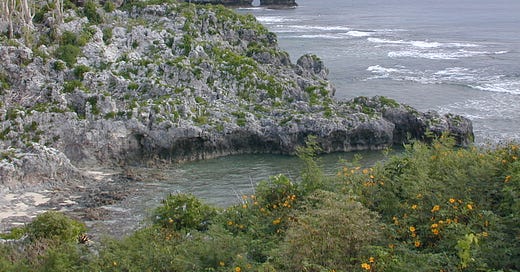Among the remote islands I’ve visited, none has been more remote than Niue. Every other island I’ve visited has been part of an archipelago. Fuvahmulah, the most remote Maldivian island, is still only forty kilometres from its closest neighbour. Mauritius is just over 200 kilometres from Reunion, the nearest inhabited island, but there are also a dozen or so smaller islands around its coastline. Rodrigues is more remote, more than 600 kilometres from Mauritius, but it does still have a few small islets nearby, with several flights arriving every day. The Hawai’ian islands are the most remote inhabited islands, but they are a large and populous archipelago. They are also well-connected with the US mainland – too well-connected for the good of the unique plants and animals found there.
But Niue is a single mass of coral rock, more than 400 kilometres from the nearest inhabited island, Vava’u in the north of the Tongan islands. It has no islets offshore, no encircling reef and no harbour. When I visited, in mid-2004, there were two planes per week, one from Samoa and one from Auckland. There was also a ship which visited every three weeks – but with no harbour, getting anything on and off was a tricky business, and it still is today. The single island makes up the whole country of Niue (which is pronounced Nee-oo-eh, not Noo-eh).
There are close connections between New Zealand and Niue, not least because around 95% of Niuean people live in New Zealand. However, it’s a country which seldom makes our news. One time it did, however, was in January 2004, when the island was hit by Cyclone Heta. Niue is used to cyclones, since they occur every few years, with a severe cyclone around once in a decade. But Heta was different, far more damaging than any other cyclone in living memory.
Two people were killed and most of the island’s infrastructure, including the hospital, satellite communications, fuel storage tanks, fishing boats, museum and all but one hotel, was either severely damaged or destroyed. Trees were stripped bare and almost all the island’s crops were wiped out. It must have been a terrifying time to be so isolated.
Much of the damage was not the result of the wind or rain. Niueans were prepared for those and had weathered them many times. The damage was done by a storm surge and very, very bad luck.
Niue is not a flat atoll like the islands of the Maldives. The centre of the 260 square kilometre island is a plateau up to 60 metres high. Surrounding the plateau is a lower terrace, more than 20 metres high. The terrace slopes steeply down to the water, where there are rock platforms, caves and rock pools, but no lagoon or beaches. It doesn’t seem like the kind of place which would be vulnerable to a storm surge.
But Cyclone Heta arrived at the height of the spring tide, the highest high tide of the month. The centre of the cyclone passed within 50 kilometres of the island at the peak of its power. The wind was blowing directly onshore at Alofi, the capital, and a submerged rock platform off the coast amplified the waves. Water surged up the cliffs, reaching buildings which would have seemed safe. I can’t imagine how frightening it must have been.
I visited Niue six months after Cyclone Heta, for two weeks. I was part of a team of four invited to look at the impact of the cyclone on invasive plants and their management on the island, as well as to survey whether the influx of aid, including building materials, had brought new species. One of the team was a scientist from the US who was spending his retirement doing my dream job – basically voluntary consultancy on invasive plants on tropical islands. He had been to some of the most remote islands of the Pacific and had already visited Niue once or twice. Another team member was an expert botanist from Australia with extensive experience in Papua New Guinea and West Papua. She’d never set foot on Niue and yet she encountered only one plant she couldn’t identify. And two of us came from the Department of Conservation in New Zealand, included for our more practical experience of controlling invasive plants. I think we were both a little overawed by the expertise of the company we found ourselves in – I know I was.
We were helped by local staff, particularly two of the younger staff from the Ministry of Agriculture. They were extraordinarily obliging, working long days in the field with us, including taking us to various sites on the Saturday. The only day they didn’t work with us was the Sunday, which was most definitely regarded as a day for church and rest. It was also really the only time we had off. I was advised that we should stay in the hotel in the morning, because it wasn’t considered a good look for us to be out and about unless we were going to church. I think we all actually worked on notes or specimens at that time.
However, on the Sunday afternoon a couple us went to visit the Limu Pools, one of Niue’s remarkable rock pools. As I mentioned, Niue isn’t surrounded by a lagoon, and there’s almost no sand. The coast is basically all cliffs of coral rock and, as is typical of coral rock, much of the surface is like broken bottles embedded in concrete. It’s the kind of place where wearing heavy leather garden gloves is a good idea if you have to navigate across it. It’s not the kind of place where you can just jump in for a dip.





